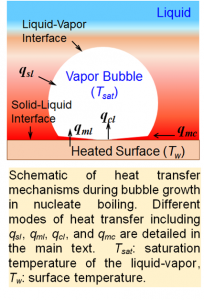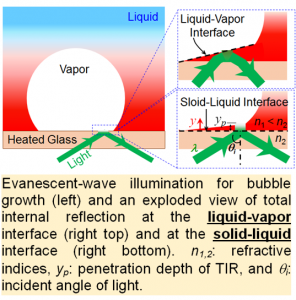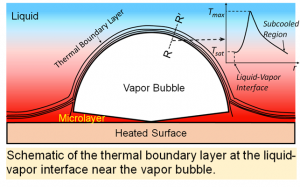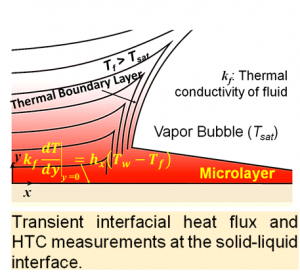1. Nucleate Boiling Mechanisms using 3D Transient Temperature Mapping
The rapid advancement of nanotechnology and microelectronics has posed huge challenges to the thermal management of extreme heat loads discharged from tightly confined areas in many electrical systems. Boiling heat transfer associated with bubble growth is perhaps one of the most efficient cooling methodologies due to its large latent heat during phase change. Despite significant enhancement of heat removal rates, numerous questions remain regarding the fundamentals of bubble growth mechanisms, a major source of enhanced heat dissipation. The research objective of this proposal is to accurately measure three-dimensional (3D), space- and time-resolved, local liquid temperature distributions surrounding a growing bubble that help better explain the heat and mass transfer to bubble growth. Local fluid temperatures in the microlayer will be interrogated by total internal reflection thermometry while fluid temperatures in the thermal boundary layer near the liquid-vapor interface will be measured by dual-tracer laser-induced fluorescence thermometry. To capture transient temperature distributions, both techniques will be combined with high-speed imaging. The transient fluid temperature data will be used to quantify time-resolved heat fluxes contributing to mass transfer near the growing bubble. The project results will illuminate the dominant heat transfer mode for fast bubble growth and therefore provide reliable methodologies to engineer surface and fluid properties for enhanced heat transfer without a trial-and-error process. Comprehensive 3D temperature information will be also used to validate the existing theoretical and experimental thermal transport models. The multidisciplinary research will build an inclusive program that effectively involves broad and diverse students and science teachers.
2. Non-Intrusive Temperature Sensors
We are aiming at developing accurate and spatially resolved thermometry techniques that can measure liquid-phase (and possibly surface) temperatures at microscale without disturbing the coolant flow. We are also interested in fundamental understanding of multiphase thermal-fluids problems at microscale for thermal management applications of electronics devices, including electro-wetting phenomena and microchannel dry-out.
3. Droplet Impingement on Electro-Wetted Surfaces
4. Microchannel Confiemnent under Bubbly and Sloggy Flow Conditions







